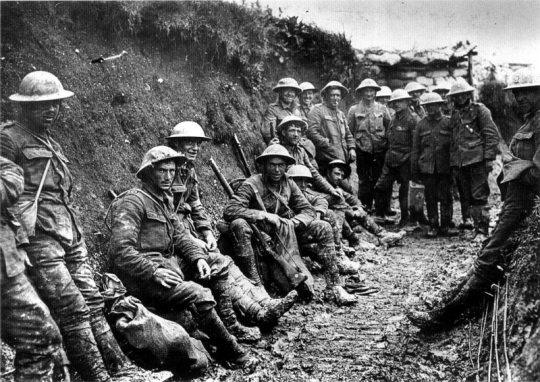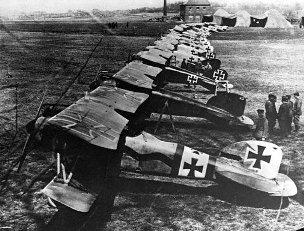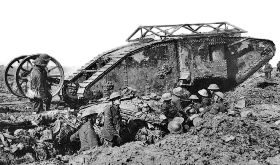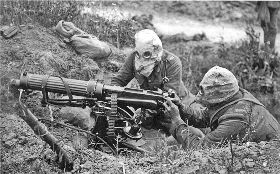Why Trench Warfare in WWI?
In the early weeks of the First World War ( summer of 1914), both German and French commanders anticipated a war that would involve a large amount of troop movement, as each side sought to gain -- or defend -- territory.
The Germans initially swept through parts of Belgium and northeastern France, gaining territory along the way.
During the First Battle of the Marne in September 1914, however, the Germans were pushed back by Allied forces. They subsequently "dug in" to avoid losing any more ground. Unable to break through this line of defense, the Allies also began to dig protective trenches. Trenches were long, narrow ditches dug into the ground where soldiers lived all day and night.

By October 1914, neither army could advance its position, mainly because war was being waged in a very different way than previous wars.
Forward-moving strategies such as head-on infantry attacks were no longer effective or feasible against modern weaponry like machine guns and heavy artillery; this inability to move forward created the stalemate.
Digging trenches was seen as a temporary strategy -- or so the generals had thought -- but it evolved into one of the main features of the war at the Western Front for the next four years.
What was it like in a World War One trench?
There were many lines of German trenches on one side and many lines of Allied trenches on the other.
In the middle, was no man's land, so-called because it did not belong to either army. Soldiers crossed No Man's Land when they wanted to attack the other side.
Food in the trenches
A total of 3,240,948 tons of food was sent from Britain to the soldiers fighting in France and Belgium during the First World War. The British Army employed 300,000 field workers to cook and supply the food. At the beginning of the war British soldiers were given 10 ounces of meat and 8 ounces of vegetables a day. As the size of the army grew and the German blockade became more effective, the army could not maintain these rations and by 1916 this had been cut to 6 ounces of meat a day. Later troops not in the front-line only received meat on nine out of every thirty days. The daily bread ration was also cut in April 1917. The British Army attempted to give the soldiers the 3,574 calories a day that dieticians said they needed. However, others argued that soldiers during wartime need much more than this.
Soldiers in the Western Front were very critical of the quantity and the quality of food they received. The bulk of their diet in the trenches was bully beef (caned corned beef), bread and biscuits. By the winter of 1916 flour was in such short supply that bread was being made with dried ground turnips. The main food was now a pea-soup with a few lumps of horsemeat. Kitchen staff became more and more dependent on local vegetables and also had to use weeds such as nettles in soups and stews. The battalion's kitchen staff had just two large vats, in which everything was prepared. As a result, everything the men ate tasted of something else. For example, soldiers often complained that their tea tasted of vegetables. Providing fresh food was also very difficult. It has been estimated that it took up to eight days before bread reached the front-line and so it was invariably stale. So also were the biscuits and the soldiers attempted to solve this problem by breaking them up, adding potatoes, onions, sultanas or whatever was available, and boiling the mixture up in a sandbag.
Rats
Many men killed in the trenches were buried almost where they fell. If a trench subsided, or new trenches or dugouts were needed, large numbers of decomposing bodies would be found just below the surface. These corpses, as well as the food scraps that littered the trenches, attracted rats. One pair of rats can produce 880 offspring in a year and so the trenches were soon swarming with them.. Millions of rats infested the trenches and some grew as big as cats.
Trench foot
Many soldiers fighting in the First World War suffered from trench foot. This was an infection of the feet caused by cold, wet and insanitary conditions. In the trenches men stood for hours on end in waterlogged trenches without being able to remove wet socks or boots. The feet would gradually go numb and the skin would turn red or blue. If untreated, trench foot could turn gangrenous and result in amputation. The only remedy for trench foot was for the soldiers to dry their feet and change their socks several times a day. By the end of 1915 British soldiers in the trenches had to have three pairs of socks with them and were under orders to change their socks at least twice a day. As well as drying their feet, soldiers were told to cover their feet with a grease made from whale-oil.
Body Lice
Men in the trenches suffered from lice. One soldier writing after the war described them as "pale light in color, and they left blotchy red bite marks all over the body." They also created a sour; stale smell. A British soldier was quoted as saying, "The lice were the size of grains of rice, each with its own bite, each with its own itch. When we could, we would run hot wax from a candle down the seams of our trousers, our vests - whatever you had - to burn the buggers out. It was the only thing to do. Eventually, when we got to back, they took every stitch off us and gave us a suit of sterilized blue material. And the uniforms they took off, they burned them - to get rid of the lice."
The truce on Christmas Day. The most beautiful video EVER.
Comment on the blog: What do YOU think would be the worst part of this experience?


